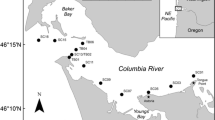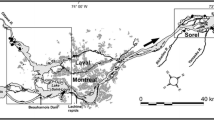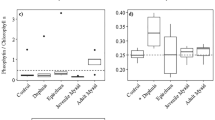Abstract
The taxonomic composition and biomass of phytoplankton in the San Joaquin River, California, were examined in relation to water depth, flow regime, and water chemistry. Without substantial tributary inflow, maintenance demands exceeded algal production during summer and autumn in this eutrophic, `lowland type' river due to light-limiting conditions for algal growth. Streamflow from tributaries that drain the Sierra Nevada contributed to a substantial net gain in algal production during the spring and summer by increasing water transparency and the extent of turbulence. Abundances of the major taxa (centric diatoms, pennate diatoms and chlorophytes) indicated differing responses to the longitudinal variation in water depth and flow regime, with the areal extent of pools and other geomorphic features that influence time-for-development being a major contributing factor to the selection of species. Tychoplanktonic species were most abundant upstream and in tributaries that drain the San Joaquin Valley. Seasonally-varying factors such as water temperature that influence algal growth rates also contributed significantly to the selection of species. Nutrient limitation appears not to be a primary constraint on species selection in the phytoplankton of this river.
Similar content being viewed by others
References
Academy of Natural Sciences of Philadelphia, 1999. Standard Operating Procedures for the Identification and Enumeration of Algae in Samples Collected for the National Water-Quality Assessment Program of the U. S. Geological Survey. P-13-39 and P-13-69, Diatoms and Soft Algae in Quantitative Samples. P-13-61, Diatoms in Qualitative Samples. Academy of Natural Sciences, Philadelphia, PA.
American Public Health Association, 1989. Standard Methods for the Examination of Water and Wastewater, 17th edition. American Public Health Association, Washington, D.C.: 1550 pp.
Bahnwart, M., T. Hübener & H. Schubert, 1999. Downstream changes in phytoplankton composition and biomass in a lowland river-lake system (Warnow River, Germany). Hydrobiologia 391: 99–111.
Cloern J. E., 1987. Turbidity as a control on phytoplankton biomass and productivity in estuaries. Continental Shelf Res. 7: 1367– 1381.
Cohn, T. A., D. L. Caulder, E. J. Gilroy, L. D. Zynjuk & R. M. Summers, 1992. The validity of a simple statistical model for estimating fluvial constituent loads: an empirical study involving nutrient loads entering Chesapeake Bay. Wat. Resour. Res. 28: 2353–2363.
Crawford, C. G., 1991. Estimation of suspended-sediment rating curves and mean suspended-sediment loads. J. Hydrol. 129: 331– 348.
Dokulil, M. T., 1994. Environmental control of phytoplankton productivity in turbulent turbid systems. Hydrobiologia 289: 65–72.
Fishman, M. J. & L. C. Friedman (eds), 1985. Methods for Determination of Inorganic Substances in Water and Fluvial Sediments. Chapter A1, Book 5 in Techniques of Water-Resources Investigations of the United States Geological Survey, U.S. Geological Survey Open-File Report 85–495, Denver, CO.
Kiss, K. T., 1996. Diurnal change of planktonic diatoms in the River Danube near Budapest (Hungary). Arch. Hydrobiol. 112. Algological Studies 80: 113–122.
Kiss, K. T. & S. I. Genkal, 1993. Winter blooms of centric diatoms in the River Danube and in its side-arms near Budapest (Hungary). Hydrobiologia 269/270: 317–325.
Kiss, K. T., J. Nosek & L. Kremmer, 1998. Diurnal change of phytoplankton, some physical and chemical components of the River Danube near Budapest (Hungary). Verh. int. Ver. theor. angew. Limnol. 26: 1041–1044.
Köhler, J., 1994. Growth, production, and losses of phytoplankton in the lowland River Spree. I. Population dynamics. J. Plankton Res. 15: 335–349.
Kratzer, C. R. & J. L. Shelton, 1998. Water Quality Assessment of the San Joaquin – Tulare Basins, California: Analysis of Available Data on Nutrients and Suspended Sediments in Surface Water, 1972–1990. U.S. Geological Survey Professional Paper 1587, U.S. Geological Survey, Denver, CO: 92 pp.
Leland, H. V., L. R. Brown & D. K. Mueller, 2001. Distribution of algae in the San Joaquin River, California, in relation to nutrient supply, salinity and other environmental factors. Freshwat. Biol. 46: 1139–1167.
Moss, B. & H. Balls, 1989. Phytoplankton distribution in a floodplain lake and river system. II. Seasonal changes in the phytoplankton communities and their control by hydrology and nutrient availability. J. Plankton Res. 11: 839–867.
Padisák, J. & C. S. Reynolds, 2003. Shallow lakes: The absolute, the relative, the functonal and the pragmatic. Hydrobiologia 506– 509: 1–11.
Reynolds, C. S., 1997. Vegetation Processes in the Pelagic: AModel for Ecosystem Theory. In Kinne, O. (ed.), Excellence in Ecology Series. Ecology Institute, Oldendorf/Luhe, Germany: 371 p.
Reynolds, C. S. & J. P. Descy, 1996. The production, biomass and structure of phytoplankton in large rivers. Arch. Hydrobiol. Suppl. 113: 161–187.
Reynolds, C. S., J. P. Descy & J. Padisák, 1994. Are phytoplankton dynamics in rivers so different from those in shallow lakes? Hydrobiologia 289: 1–7.
Reynolds, C. S. & M. S. Glaister, 1993. Spatial and temporal changes in phytoplankton abundance in the upper and middle reaches of the River Severn. Arch. Hydrobiol. Suppl. 101: 1–22.
Sabater, S. & I. Muñoz, 1990. Successional dynamics of the phytoplankton in the lower part of the river Ebro. J. Plankton Res. 12: 573–592.
Shelton, L. R., 1994. Field Guide for Collecting and Processing Streamwater Samples for the National Water-Quality Assessment Program. U.S. Geological Survey Open File Report 94-455, Denver, CO.
Shelton, L. R. & L. K. Miller, 1988. Water-Quality Data, San Joaquin Valley, California, March 1985 to March 1987. U.S. Geological Survey Open File Report 88–479, Denver, CO.
Shoaf, W. T. & B.W. Lium, 1977. The quantitative determination of chlorophyll a and b from freshwater algae without interference from degradation products. J. Res. U.S. Geol. Survey 5: 263– 264.
Sournia, A., 1978. Phytoplankton Manual. United Nations Educational, Scientific, and Cultural Organization. Paris, France: 337 pp.
Tikkanen, V., 1986. Kasviplanktonopas. Suomen Luononsvujehn Tuki Oy, Helsinki, Finland.
U.S. Army Corps of Engineers, 1998–2002. US Army Engineer District, Sacramento, and The Reclamation Board of the State of California. Sacramento and San Joaquin River Basins Comprehensive Study.
Vörös, L., K. V.-Balogh, S. Herodek & K. T. Kiss, 2000. Underwater light conditions, phytoplankton photosynthesis and bacterioplankton production in the Hungarian section of the River Danube. Arch. Hydrobiol. Suppl. 115/4: 511–532
Author information
Authors and Affiliations
Rights and permissions
About this article
Cite this article
Leland, H.V. The influence of water depth and flow regime on phytoplankton biomass and community structure in a shallow, lowland river. Hydrobiologia 506, 247–255 (2003). https://doi.org/10.1023/B:HYDR.0000008596.00382.56
Issue Date:
DOI: https://doi.org/10.1023/B:HYDR.0000008596.00382.56




